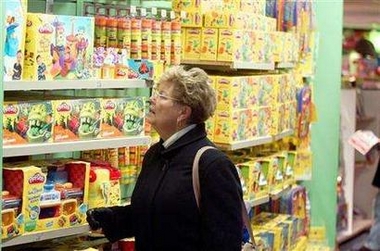Doctors may soon have a prescription for health that even kids will like:
more playtime. European and international health experts say a new study makes
the most convincing case yet for the benefits of children being active. They say
the research may lead to new guidelines saying youngsters between ages 5 and 16
need to be active up to 1 1/2 hours a day.

A woman at a Toys 'R'
Us store in New York, November 25, 2005. Adding weights to children's toys
may help them improve their fitness during playtime, the results of a
small study suggest. [Reuters] |
For some parents, that might be accomplished simply by showing their children
the door.
"Just making sure children play outside will double the amount of physical
activity they get," said Dr. Lars Bo Andersen, lead author of the research
published Friday in the medical journal Lancet.
Experts said the study doesn't mean children need to be on treadmills or in
soccer leagues — they just need to be able to run around and play physically,
even for short bursts of time.
Concerned by flaws in previous studies, Andersen and his colleagues set out
to examine the connection between children's physical activity and risk factors
for heart disease and diabetes.
The study looked at 1,732 9-year-olds and 15-year-olds from Denmark, Estonia
and Portugal. Physical activity was monitored for four consecutive days by
strapping little machines to the youngsters' hips, which monitored accelerations
in body movements.
Despite differences among the three countries where children were monitored,
the benefits of physical activity were consistent. The more active children had
healthier numbers for blood pressure, cholesterol and insulin.
"This effect is not dependent on one country or one ethnic group, and it is
probably applicable in almost any population," said Dr. Ram Weiss, a
pediatrician at the Hebrew University Medical School, and author of a commentary
in Lancet on Andersen's study.
Because it measures activity objectively, without relying on questionnaires,
Andersen's research may lead to a reconsideration of physical activity
guidelines by countries and global health organizations.
"This is much stronger evidence than we've ever had before," said Nick
Cavill, a research associate in the public health department at Oxford
University, who wasn't involved in the study.
About 40 percent of those monitored were reasonably active, while the rest
were sedentary, researchers said. The study found that the benefits of physical
activity applied to all children — not just to obese children, normally thought
to be at higher risk.
While much attention has been paid to children's bad eating habits,
Andersen's study calls for equal weight to be placed on activity levels.
"It would be a mistake only to look at this as an obesity problem," he said.
"A lot of children have metabolic problems without being fat. ... It's a
question of getting them to be more active and less sedentary."
However, parents shouldn't take that to mean that a radical change in their
children's routine is necessary.
"We don't need to be getting kids running in the gym on treadmills," said
Cavill. "We need to encourage kids to play." One of the study's key findings, he
explained, is that it proves the utility of short bursts of activity, rather
than a need for continuous exercise.
The researchers said physical activity does not demand intense exercise, such
as playing soccer or tennis. "There is a value to five- and 10-minute bouts of
activity, where kids will run for a little while and then stop," said Cavill.
Pushing more physical activity for kids requires government policy changes,
which Andersen said have already started to happen in some countries. For
instance, schools in Denmark and Norway now include more physical education
classes.
Designing schools and neighborhoods to be child and exercise-friendly would
also help.
"Urban planners need to put more focus on things like road safety and the
design of a neighborhood, so that children will be safe when they're playing
outside," said Roar Blom, a physical activity expert with the World Health
Organization.
But perhaps the greatest factor in children's physical activity will be the
parents themselves.
"It's not just that children should be more active, it's the whole family,"
said Weiss. "Parents should be role models."